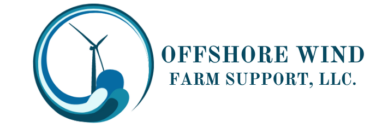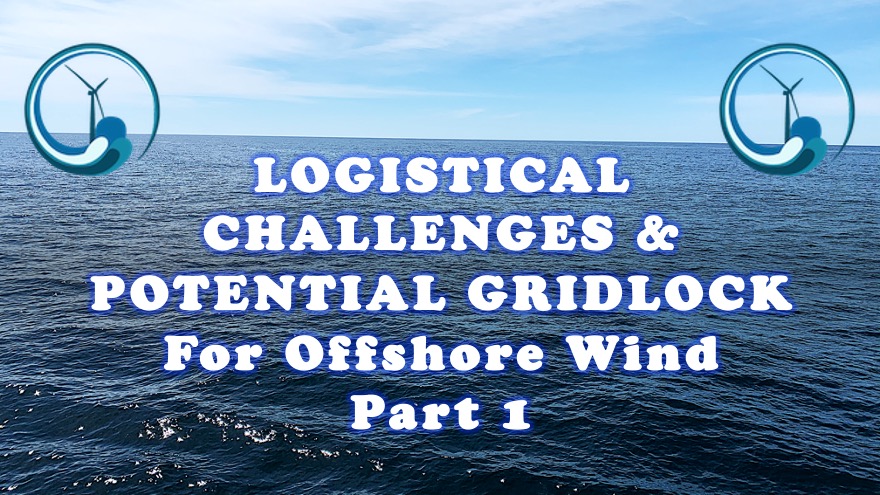Putting the Offshore Wind Industry on Notice of Logistical Challenges and Potential Gridlock
August 24, 2021 Dateline- a few days after tropical storm Henri headed up the eastern seaboard. All ports large enough to handle Offshore Wind Survey Vessels were FULL for dockage, and turbine construction hasn’t even started yet!
Before we get into the “meat” of this post, I’d like to frame it by telling you a short story about Port Fourchon.
A once non-descript bayou draining out to the Gulf of Mexico, now is home to about 800 boats ranging from 90’ up to 330’. This port services about 600 oil platforms in the Gulf of which, about 16-18% of the Nations Oil Supply comes from.
“Fourchon” as it’s known to mariners in the oil business, is a working madhouse with boats coming and going 24/7.
- To the inexperienced eye, a chaotic maze of vessels.
- To the experienced, it’s a thing of beauty. Different size and shape vessels navigating the waterway like a well-choreographed dance on a Broadway stage.
At any given time, no matter where one looks, there will be 30-35 boats going in different directions.
Crew change days are Tuesdays, Wednesdays and Thursdays, and traffic is like big city rush hour traffic, with BIG boats instead of automobiles.
When boats come in for crew change, they also take on supplies, pump fuel, replenish fresh water and transfer cargo in a strictly limited timeframe.
If a fuel time slot is missed for any reason, the boat goes to the back of the line and may need to “push mud” for a few hours. (almost like back in the day before “snowflakism” when a teacher made you put on a dunce cap and sit on a stool in the corner of the room.)
Pushing Mud?
Yes – let me explain: In Fourchon, there simply isn’t enough dock space to go around so boats are forced to go the other side of the bayou, run the bow into the mud and wait. Hence the name “pushing mud.”
So a little information about Fourchon can give you an idea of what is coming to Offshore Wind.
(except pushing mud is impossible in New England because of the rocky shorelines).
We had a coastal storm approach the eastern seaboard a couple days ago and a clear dilemma for dockage for Offshore Wind Vessels became apparent! Boats were clamoring for spots and my phone rang off the hook with boats looking for dockage.
Some satisfied, some not!? The only good thing was, that this wasn’t an epic storm, it was a rain and wind event with some local flooding on shore- not even remarkable power outages reported.
As the title of this post suggests, “Logistical Challenges and Gridlock Coming to Offshore Wind,” there simply isn’t enough dock space to go around in one port and boats will inevitably be scattered about.
Based on this simple fact, there is going to be a need for a central point of operations for ALL Offshore Developers and Wind Farms to operate from safely and properly. This cannot be overstated; it will be an IMMENSE challenge in the future.
Let me give you a few necessary action items that need to happen every time a boat comes to the dock and be completed before the boat can head back out.
| CREW | FUEL | FOOD | WATER | SUPPLIES |
| CARGO | PARTS | MAINTENANCE | PAYROLL | PAPERWORK |
Lets’ Take a Quick Look At Each One of The “Action Items”
Crew: Scheduling, they need to get to the docks themselves or transportation arranged. There will be excuses, no shows, requirements for cigarettes, clothes, boots and a whole lot more. (Trust Me – This Always Has Been, and Always Will Be An Issue!)
People will be coming in from all over the world to work in Offshore Wind.
In the oil field, they call it “rotation” where a person comes in for a 4 to 6 week hitch and work in rotation of 4-6 weeks on and 4-6 weeks off. This alone would be a challenge for the best travel agents, as we’re talking planes, trains and automobiles coming and going on crew change days
Let’s not forget onboarding, training, qualifications, proper documentation, and scheduling etc. The paperwork alone will be staggering, and it must be digitized and easily accessible. Tracking vessels, employees and technicians, random drug testing (Covid concerns notwithstanding) and everything else that goes along with it, we’re talking a massive undertaking!
This Undertaking Will Be Virtually Impossible
If Not Systematized, Digitized, and Computerized
Fuel: Fuel needs must be arranged before vessels arrive to the dock. The fuel man will need to make sure he has it on hand for delivery. While it might be an easy thing to order a hundred gallons for home heating, or be put on a scheduled delivery, it doesn’t happen this way around the docks. One missed or late phone call could mess up the entire logistical chain not only for the one boat, but for an entire fleet. If you have ever gotten stuck in an airport waiting on a delayed flight, you understand exactly what I’m talking about.
Water: Water doesn’t just magically appear. Water lines need to be run and they be readily accessible to the vessels immediately. This might sound ridiculous to those who work out of a house or in an office an where water is at your fingertips, but it’s not on a boat. It is a limited commodity and needs to be transferred to a holding tank for future use, and scheduled for.
Supplies: This is a big one – supplies need to be ordered, inventoried, logged, stacked, wrapped, palletized, labeled and staged in a location that they can be easily and swiftly retrieved. If the supplies are coming in from another country, add in customs, transatlantic shipping, tracking, etc. And again, paperwork needs to follow, inventory checked off, signatures of confirmation, etc.
Maintenance: Boats need maintenance and engines need oil changes, fuel, oil and air filter changes for main engines and generators, pressure relief valves need to be checked regularly, pumps need replacement or repair, etc. Much can be done while offshore, but some vessel needs and times necessary at the dock create traffic. (Think of taking your car to get the brakes looked at and an oil change)
Then we have unscheduled maintenance – Engine and mechanical breakdowns, shipyards, USCG safety inspections, etc. You can’t just pull a boat off the line without having a backup standing by. This is big business and like the airlines, you can’t just pull a vessel out of the lineup without having a replacement!
Food: You can’t simply run to the grocery store and buy a dozen eggs and a gallon of milk. Depending on the length of the boat and size of the crew, the food bills will generally run in the $500- $1,000 per day range and you will need 7 to 60 days-worth of supplies at once. It will need to be delivered in trucks with pallets, separated by dry and canned goods, refrigerated and frozen goods. There will be a need for shoreside storage areas, trucks will need to be arranged and tight schedules kept so the boat can turn around quickly.
Remember – Once Offshore … There Is No Such Thing
As A Convenience Store Just Around The Corner
Cargo: Similar to supplies, cargo needs to be located, ordered, inventoried, logged, stacked labeled and stored in a specific location, easily retrieved. Paperwork needs to flow, inventory checked off, signatures, etc. Until the USA has complete manufacturing, parts will come in from other parts of the world, gone through customs and transported to the proper location.
Parts: Turbines need to be maintained and parts wear out! Oil, Filters, bearings, switches, gauges and who knows what else will need to be ordered, shipped, delivered, inventoried shore-side and placed on the vessel when needed and that leads up into #9.
Paperwork: Never-Ending paperwork. Daily logs of crew, weather, work performed, JSA filings, bills of laden from previous trips, fuel invoices, supply orders, receipts, crew change orders and safety reports all need to be printed, emailed and/or transferred to the office. Paperwork is a never-ending process (battle) and need to be kept up to date. Again, it will all need to go into a centralized database for access from any number of people working in the industry.
Whoops – I almost forgot the most important part (not really) …. invoicing, receivables, time tracking and Payroll for Employees.
Are you “getting” the picture yet?
This Undertaking Will Be Virtually Impossible
If Not Systematized, Digitized, and Computerized
According to BOEM, the entire US eastern seaboard is currently planning for 2,060 turbines. NY and NJ are battling amongst themselves for another 3,000 or so and recently South Carolina decided to throw its hat in the ring.
When all is said and done, the eastern seaboard is looking at 4,000 to 5,000 turbines which will require 400 – 500 CTV’s and another 50 or so 300’ boats!
If this isn’t planned out ahead of time and run from a central source, it’s going to be an absolute nightmare!
Over the past 18 months, a group of us have been masterminding, planning and combining our strengths, levels of expertise and experience and aligning ourselves to offer complete solutions some of the most experienced companies and talent in the marine industry.
Over the next few weeks I’ll be expanding on each of the above mentioned Action Items and how our group will be collectively addressing each one.
To the best of my knowledge, we are putting together the most extensive and complete Offshore Wind Servicing Platform in the the Country.
Soon we will have complete port facilities, dockage, storage, food warehousing and delivery services, and an expansion of ‘on demand’ concierge services for the Wind Developers.
Stand By – More Will Be Revealed In Coming Posts!

